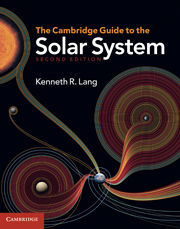Book contents
- Frontmatter
- Contents
- List of focus elements
- List of tables
- Preface to the second edition
- Preface to the first edition
- Principal units
- Part 1 Changing views and fundamental concepts
- Part 2 The inner solar system: rocky worlds
- Part 3 The giant planets, their satellites and their rings: worlds of liquid, ice and gas
- Part 4 Remnants of creation: small worlds in the solar system
- 12 Asteroids and meteorites
- 13 Colliding worlds
- 14 Comets
- 15 Beyond Neptune
- Part 5 Origin of the solar system and extrasolar planets
- Author index
- Subject index
15 - Beyond Neptune
from Part 4 - Remnants of creation: small worlds in the solar system
Published online by Cambridge University Press: 05 August 2011
- Frontmatter
- Contents
- List of focus elements
- List of tables
- Preface to the second edition
- Preface to the first edition
- Principal units
- Part 1 Changing views and fundamental concepts
- Part 2 The inner solar system: rocky worlds
- Part 3 The giant planets, their satellites and their rings: worlds of liquid, ice and gas
- Part 4 Remnants of creation: small worlds in the solar system
- 12 Asteroids and meteorites
- 13 Colliding worlds
- 14 Comets
- 15 Beyond Neptune
- Part 5 Origin of the solar system and extrasolar planets
- Author index
- Subject index
Summary
• The discovery of Pluto was serendipitous, the result of a long careful search based on incorrect predictions.
• Pluto moves between 29.7 and 49.3 AU from the Sun, and just crosses within the orbit of Neptune, at 30 AU, without ever colliding with it.
• Pluto has a thin atmosphere of nitrogen, methane and carbon dioxide, and large variable dark and light surface makings.
• Pluto has three companion moons, named Charon, Nix and Hydra. Charon is an oversized satellite, about half the size of Pluto.
• The New Horizons spacecraft will encounter Pluto in 2015, to study its atmosphere, surface and interior, then travel into the Kuiper belt.
• Centaurs are small bodies that orbit the Sun between Jupiter and Neptune and cross the orbit of one or more giant planets. They are thought to originate further away from the Sun in the Kuiper belt. Some centaurs display comet comas, and most of them are expected to become comets.
• Several trans-Neptunian objects orbit the Sun beyond the orbit of Neptune, including Eris, Makemake and Haumea. They are either larger than Pluto or comparable to it in size.
• Pluto has been demoted from the ninth major planet to a dwarf planet, and then reclassified as a plutoid.
• A dwarf planet orbits the Sun and has a rounded shape, but it does not clear out the orbit around it. The asteroid 1 Ceres has been designated a dwarf planet. […]
- Type
- Chapter
- Information
- The Cambridge Guide to the Solar System , pp. 435 - 444Publisher: Cambridge University PressPrint publication year: 2011



